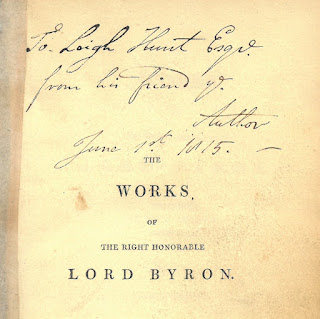 Prepping for this week's class on British Romanticism helped us "discover" the Wordsworth Sonnets edition we just blogged. It also turned up a pretty cool double association copy. Our copy of the four volume Works of the Right Honorable Lord Byron (London: John Murray, 1815) came to us as one of one-hundred volumes from the library of James T. Fields bequeathed to Dartmouth by his widow in 1915. Fields was a partner in the legendary Boston firm Ticknor and Fields, the primary publisher of books from the nineteenth-century American Renaissance. Field's hobnobbed with the literati on both sides of the Atlantic, and his library is a stunner. Just having been owned by Fields makes this a pretty good association copy.
Prepping for this week's class on British Romanticism helped us "discover" the Wordsworth Sonnets edition we just blogged. It also turned up a pretty cool double association copy. Our copy of the four volume Works of the Right Honorable Lord Byron (London: John Murray, 1815) came to us as one of one-hundred volumes from the library of James T. Fields bequeathed to Dartmouth by his widow in 1915. Fields was a partner in the legendary Boston firm Ticknor and Fields, the primary publisher of books from the nineteenth-century American Renaissance. Field's hobnobbed with the literati on both sides of the Atlantic, and his library is a stunner. Just having been owned by Fields makes this a pretty good association copy. But there's more! This copy was a presentation copy from Lord Byron to the poet, journalist, and critic, Leigh Hunt. Hunt was a champion of the romantics and helped to popularize Byron, Keats, and Shelley (though he disliked Blake). So it is no surprise that Byron would grace him with a copy of this works. Interestingly, the book was presented to Hunt on June 1st, 1815. That was shortly after Hunt had been released from prison where he had served a two-year sentence for having slandered the Prince Regent, who would later be crowned George IV.
But there's more! This copy was a presentation copy from Lord Byron to the poet, journalist, and critic, Leigh Hunt. Hunt was a champion of the romantics and helped to popularize Byron, Keats, and Shelley (though he disliked Blake). So it is no surprise that Byron would grace him with a copy of this works. Interestingly, the book was presented to Hunt on June 1st, 1815. That was shortly after Hunt had been released from prison where he had served a two-year sentence for having slandered the Prince Regent, who would later be crowned George IV.There are lots of markings in the book and some corrections. We think they are Leigh Hunt's hand, but they may be Fields's notes.
To see it ask for Fields 13.
![An image of a two-page spread of Wordsworth's 1838 first edition of "The Sonnets of William Wordsworth." On the left-hand side, a handwritten note by Wordsworth that reads, "The Lady Frederic Benti[nck?] from her friend William Wordsworth. On the right-hand page, "The Sonnets of William Wordsworth / Collected in one volume / with / a few additional ones, now first published / London: / Edward Moxon, Dover Street. / MDCCCXXXVIII"](https://blogger.googleusercontent.com/img/b/R29vZ2xl/AVvXsEhjT6p-gAC4IddqmH0rK9JQpvtmVzY6J_Snr2eoH546HODeZiaRyinY0VMD-10fYbyPyqh-T_aDz0Jo9K_wsGi6EDGSneMXF_YS5UzgSEGy8dy93Bh2Z_-bsTXwDzgY-VDSIQnE1123r60/s200/SKM_C30817011716350_0001.jpg)

